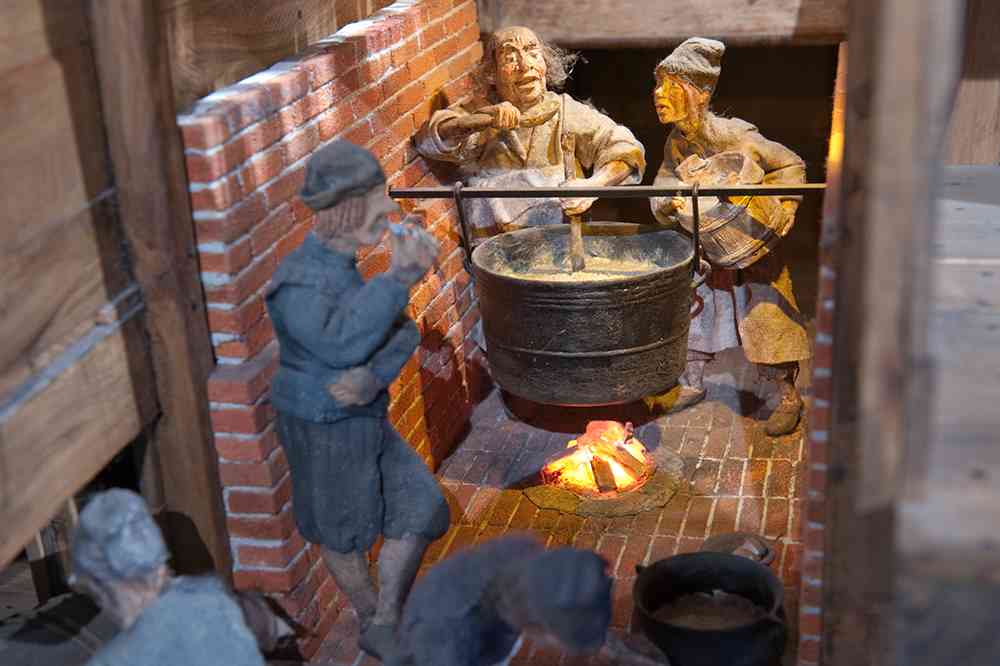450 men crowded into less than 600 square meters of living space, sleeping in shifts, eating from communal bowls, disease an ever-present risk, tedium the order of the day. But the food was regular, the duty was clearly defined, and unlike in the army, you could come home in the winter.
Vasa only sailed for a few minutes before sinking in a light breeze in Stockholm harbour, so life aboard never had time to start, but what would it have been like spending months at a time on board a warship in the 1620s? From the perspective of our lives today, it would seem both harsh and dull, with monotonous food, cramped quarters, brutal punishments and unending routine, while confined most of the time to the dim half-world of the gundecks.
From farm boys to sailors
In the 1620s, over four-fifths of the sailors in the Swedish navy were conscripts. Officials visited selected parishes in coastal districts, where they took every tenth man between the ages of 18 and 48 for naval service. If they had prior maritime experience, they were eligible between 15 and 65. While the navy was looking for mariners, what they got was a mixed bag of drifters, undesirables and strong farm lads, with a leavening of unemployed labourers and a few craftsmen. These men had to learn the navy life, how to haul a line or tie a knot, how to steer and how to get along in their watches, all at the hands of the small number of professionals who made up the backbone of a ship's crew.
Sailors and soldiers, carpenters and kings
According to the navy's planning for 1628, Vasa's crew should have comprised 133 mariners and 300 soldiers, although the soldiers were only taken on board when the ship departed for battle service; they were not on board when the ship sank. The mariners included 90 ordinary seamen led by a few able-bodied seamen and eight petty officers, under the overall command of the captain and two lieutenants, who held commissions from the king. The senior petty officer, the master, was the leading professional on board, an experienced mariner who converted the wishes of the officers into specific. A master gunner and 20 gunners led crews made up from the soldiers, while a provost maintained discipline and directed damage control in battle. A purser kept account of the provisions while a cook prepared meals, and a barber cut hair and looked after the health of the crew. Outside of these men, the navy yard provided a group of carpenters to maintain the ship, a priest took care of the spiritual needs of the crew, a trumpeter or drummer communicated orders, and a number of ship's boys, usually over the age of 12, carried messages and charges for the guns as well as acting as servants for the officers. Because Vasa was a flagship, it would be expected to carry an admiral and his servants as well.
On watch and off
The sailing crew was divided into two watches under the two lieutenants, each working for four hours while the other rested. While off duty, they were expected to stay below decks and out of the way, but could be called to work at any time if all hands were required, such as when anchoring or making a major sail change. When below, they probably tried to sleep as much as they could, since the four-hour schedule is not natural and quickly leads to fatigue. When not sleeping, they probably used much of the time off watch to mend their clothes and shoes, but they might relax with games, music or a popular new pastime, smoking, although this was only allowed in the cookroom.
The navy did not issue uniforms in the 17th century, the men had to buy or make their own clothes. In some cases cloth was provided as part of their salary, but the typical sailor's clothing was the same as the clothing they arrived in from the farm or town: a linen shirt, a short, skirted woollen doublet (jacket), wool trousers that ended below the knee, woollen socks, and leather shoes. Many had broad-brimmed hats or conical caps. The cloth varied from coarse homespun to imported dyed fabrics, but almost all sailors sewed strips of contrasting cloth or even lace down the outside seams of their trousers in imitation of the clothing worn by the well-to-do. Clothes had to be hard-wearing, since most people could not afford more than one set.
Dull food but nutritious
We would find the diet of the 17th century, on land or at sea, monotonous. In the navy, the base of the diet was salted meat for protein and dried peas and bread for carbohydrates. Barrels full of bones found in the hold show that the meat was mostly beef, with a little pork and mutton, as well as fish and poultry. Some of the crew were prepared to supplement this, as fishing equipment and hunting weapons were found, as well as the bones of roe deer, moose, and grouse. The skeletons of chickens suggest that a few fresh eggs were available.
Food was prepared in the cookroom, a brick-lined hearth in front of the mainmast in the hold, and carried up to the gundecks in buckets, where it was doled out into big wooden bowls. Each man had his own wooden spoon, and some had wooden plates, but most ate from the bowl shared by a mess, a group of six or seven men who ate and lived together. They drank weak beer, "ship's ale," from a shared wooden tankard.
A different world
The senior officers lived aft in the cabins of the sterncastle, where they had more space, glass windows, proper furniture, and ate their meals from pewter or earthenware table service. They had finer clothes, but as more than one visitor to Sweden from the continent remarked, it was difficult to tell the nobles from the peasants, since they dressed alike. The officers also had to share their accommodation, sleeping in pairs in narrow double beds, but the cabins were built to resemble the interior of houses ashore. The great cabin, where the king or an admiral would stay, was fitted out like a room in the royal palace, with fine panelling and carved sculptures that emphasised the power of the people who lived there.
Hard discipline and respect
The 17th century was a violent period, and both on shore and at sea brutal punishments were prescribed for even minor crimes. Conscripts often came from rough backgrounds, but discipline was essential for the smooth and safe functioning of a ship. In crowded conditions, small disagreements could easily blow up into fights, grumbling could turn to mutiny. Officers had to earn the trust of the men they commanded, but needed the option of punishment for the intractable. The articles of war specified that a person causing a fire was to be cast into the same fire, a person starting a fight was to be stabbed through the hand with a knife, blasphemers and those speaking ill of the king or his officers were to be keelhauled, murderers should be tied to their victims and thrown in the sea. In practice, a captain who had to use these punishments too often risked losing the respect of his men and his fellow captains and could not rule for long.
Germs more deadly than cannon
In all wars before the 20th century, disease claimed more soldiers and sailors than battle. The causes of disease were poorly understood, and the living conditions on board ships were perfect for the spread of infection. Hygiene was marginal, ventilation was poor, and the men had little chance to wash themselves or their clothes. If one man fell ill, overcrowding meant it would spread rapidly. There was no way to cure any disease in this period, one could only treat the symptoms, so many diseases were fatal. Poor food on long blockades led to nutritional deficiencies that broke down the immune system. Treatments were often ineffective or even dangerous.
On the other hand, battlefield medicine was relatively well developed. Wounds and injuries could be treated effectively if infection did not set in. More than half of the skeletons found in the ship have healed broken bones, most of them properly set, and there is also evidence of healed amputation. Men could survive horrific wounds, thanks to quick treatment and the extraordinary resilience of the human body, but many ended up maimed or crippled.
The barber was responsible for medical care, stitching wounds, setting broken bones, amputating shattered limbs, and prescribing herbal remedies, enemas and purges for the host of illnesses that affected men living so close together, from dysentery to malaria and various venereal diseases.
Still, sailors were better off than their brothers in the army. They were less likely to face enemy action, they did not spend the winter in pestilential camps, and they were fed more regularly and with better provisions. Conscription into the army was widely feared as tantamount to a death sentence.

